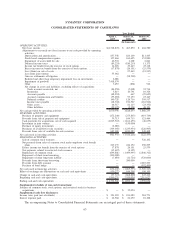Symantec 2009 Annual Report Download - page 132
Download and view the complete annual report
Please find page 132 of the 2009 Symantec annual report below. You can navigate through the pages in the report by either clicking on the pages listed below, or by using the keyword search tool below to find specific information within the annual report.subjective variables. These variables include our expected stock price volatility over the term of the awards, actual
and projected employee stock option exercise and cancellation behaviors, risk-free interest rates and expected
dividends. We estimate the expected life of options granted based on an analysis of our historical experience of
employee exercise and post-vesting termination behavior considered in relation to the contractual life of the option.
Expected volatility is based on the average of historical volatility for the period commensurate with the expected
life of the option and the implied volatility of traded options. The risk free interest rate is equal to the U.S. Treasury
constant maturity rates for the period equal to the expected life. We do not currently pay cash dividends on our
common stock and do not anticipate doing so in the foreseeable future. Accordingly, our expected dividend yield is
zero. The fair value of each RSU is equal to the market value of Symantec’s common stock on the date of grant. The
fair value of each ESPP purchase right is equal to the 15% discount on shares purchased.
Concentrations of Credit Risk
A significant portion of our revenues and net (loss) income is derived from international sales and independent
agents and distributors. Fluctuations of the U.S. dollar against foreign currencies, changes in local regulatory or
economic conditions, piracy, or nonperformance by independent agents or distributors could adversely affect
operating results.
Financial instruments that potentially subject us to concentrations of credit risk consist principally of cash and
cash equivalents, short-term investments, trade accounts receivable, and forward foreign exchange contracts. Our
investment portfolio is diversified and consists of investment grade securities. Our investment policy limits the
amount of credit risk exposure to any one issuer and in any one country. We are exposed to credit risks in the event of
default by the issuers to the extent of the amount recorded in the Consolidated Balance Sheets. The credit risk in our
trade accounts receivable is substantially mitigated by our credit evaluation process, reasonably short collection
terms, and the geographical dispersion of sales transactions. We maintain reserves for potential credit losses and
such losses have been within management’s expectations. See Note 12 for details of significant customers.
Advertising costs
Advertising costs are charged to operations as incurred and include electronic and print advertising, trade
shows, collateral production, and all forms of direct marketing. Starting in January 2007, certain advertising
contracts contain placement fee arrangements with escalation clauses which are expensed on an estimated average
cost basis over the term of the arrangement. The difference between the actual placement fee paid and the estimated
average placement fee cost is included in Other long-term liabilities for fiscal 2009 and 2008, which were
$47 million and $71 million, respectively. Advertising costs included in Sales and marketing expense for fiscal
2009, 2008, and 2007 were $572 million, $555 million, and $382 million, respectively.
Newly Adopted and Recently Issued Accounting Pronouncements
In April 2009, the FASB issued (1) FSP FAS 115-2 and FSP FAS 124-2, which provides guidance on
determining other-than-temporary impairments for debt securities; and (2) FSP FAS 107-1 and FSP APB 28-1,
which provides additional fair value disclosures for financial instruments in interim periods. Each of these FSPs are
effective for interim and annual periods ending after June 15, 2009. We do not expect the adoption of these FSPs to
have a material impact on our consolidated financial statements.
In June 2008, the FASB issued EITF Issue No. 07-5, Determining Whether an Instrument (or an Embedded
Feature) Is Indexed to an Entity’s Own Stock. EITF Issue No. 07-5 provides guidance on evaluating whether an
equity-linked financial instrument (or embedded feature) is indexed to a company’s own stock, including evaluating
the instrument’s contingent exercise and settlement provisions. EITF Issue No. 07-5 is effective for fiscal years
beginning after December 15, 2008. We are currently assessing the impact of EITF Issue No. 07-5 on our
consolidated financial statements.
72
SYMANTEC CORPORATION
Notes to Consolidated Financial Statements — (Continued)
























